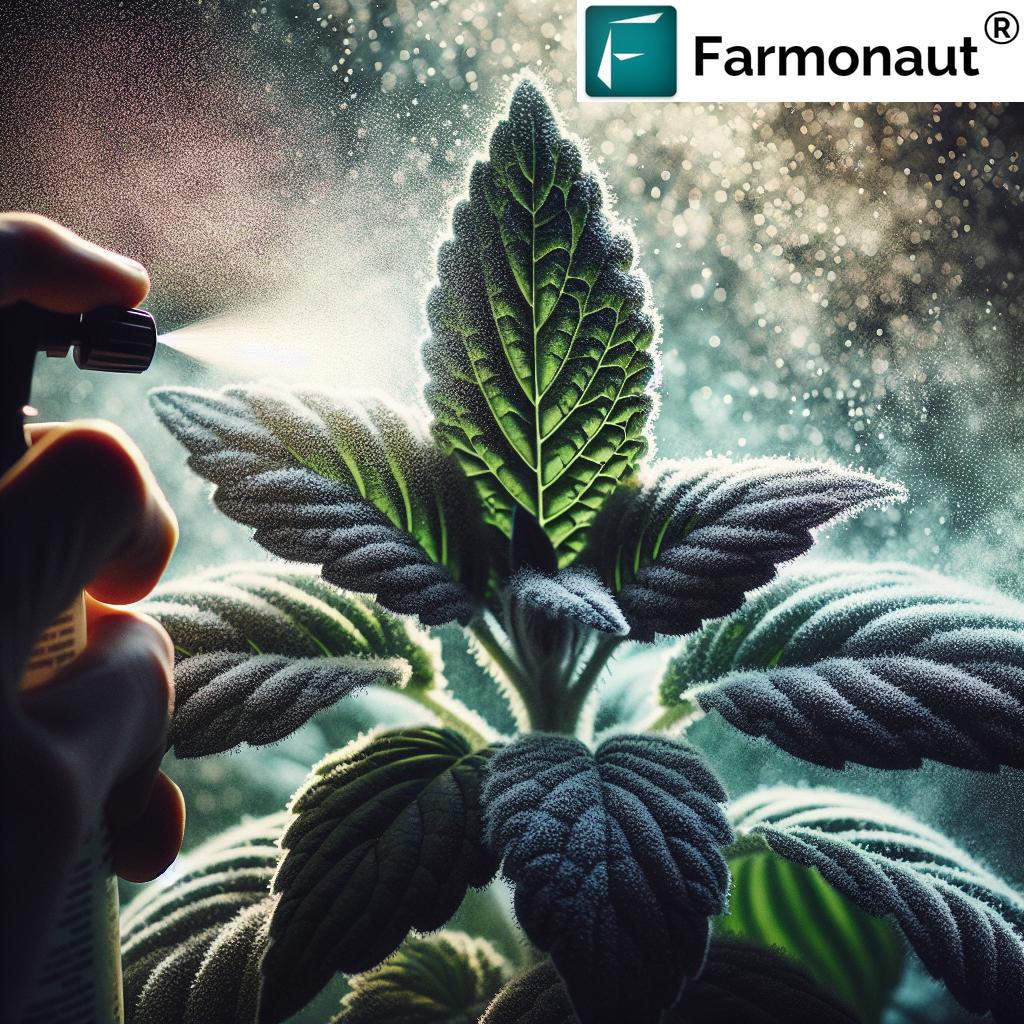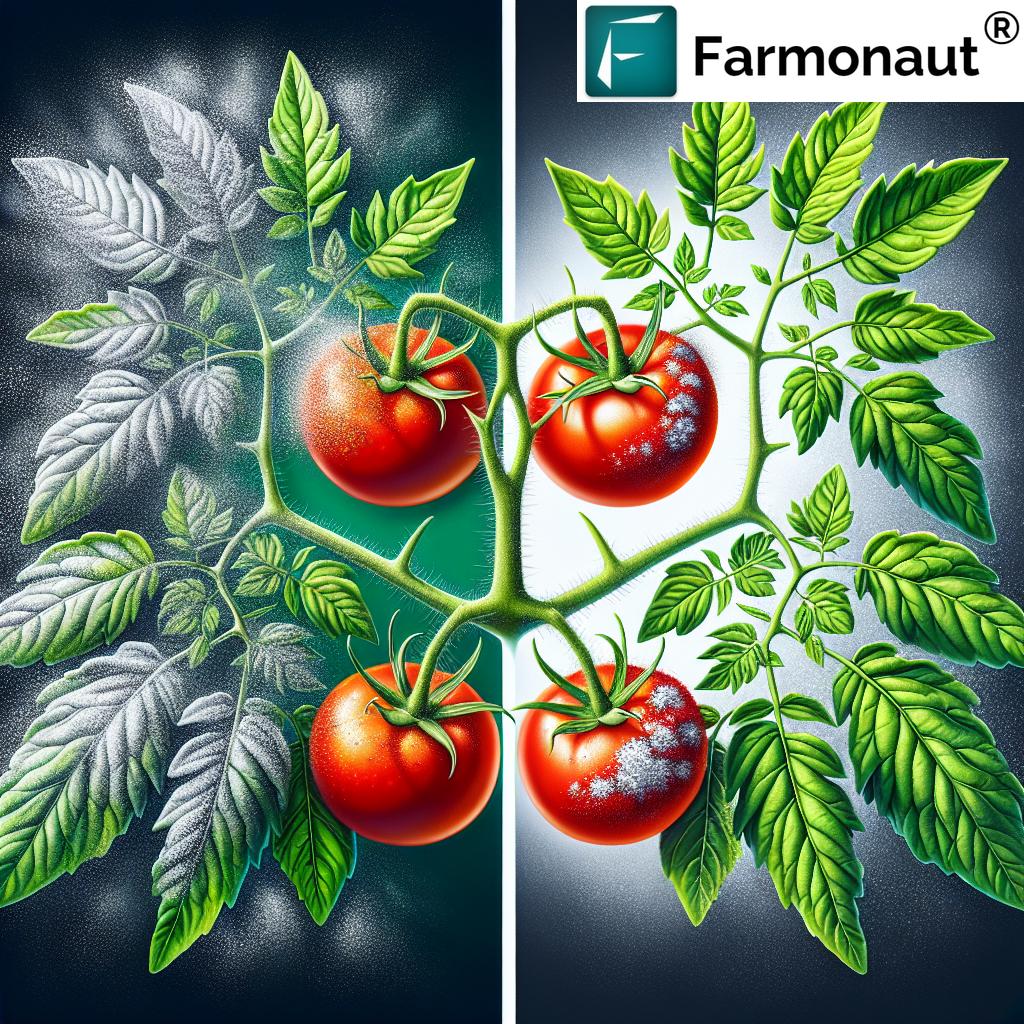Effective Organic and Chemical Control: Powdery Mildew Treatment for Crop Protection

At Farmonaut, we understand the critical importance of protecting crops from devastating diseases like powdery mildew. This comprehensive guide will delve into the intricacies of powdery mildew, its impact on crops, and the most effective organic and chemical control methods to safeguard your harvests.
Understanding Powdery Mildew: A Pervasive Threat to Crop Health
Powdery mildew is a fungal disease that affects a wide range of plants, including many important agricultural crops. It’s caused by various species of fungi, with Oidium neolycopersici being one of the most common culprits in tomato crops. This disease is characterized by the appearance of white, powdery spots on leaves, stems, and sometimes fruits, which can significantly impact crop yield and quality.
The Lifecycle of Powdery Mildew
- Spore Production: The fungus produces tiny spores that are easily dispersed by wind.
- Germination: When conditions are favorable, these spores land on plant surfaces and begin to germinate.
- Infestation: The fungus penetrates plant cells and begins to extract nutrients, weakening the plant.
- Spread: As the infestation progresses, more spores are produced, continuing the cycle.
Conditions Favoring Powdery Mildew Growth
Understanding the conditions that promote powdery mildew growth is crucial for effective prevention and control:
- High humidity (but not direct water on leaves)
- Moderate temperatures (60-80°F or 15-27°C)
- Poor air circulation
- Overcrowded plantings
- Excessive nitrogen fertilization
The Impact of Powdery Mildew on Crop Production
Powdery mildew can have severe consequences for crop health and yield:
- Reduced photosynthesis due to leaf coverage
- Stunted growth and weakened plants
- Premature leaf drop
- Reduced fruit quality and yield
- Increased susceptibility to other pests and pathogens
Early Detection: The Key to Effective Control
Early detection of powdery mildew is crucial for implementing timely control measures. At Farmonaut, we leverage advanced satellite technology to provide farmers with early warnings of potential infestations.
| Feature | Traditional Powdery Mildew Detection | Farmonaut Satellite System Detection |
|---|---|---|
| Detection Speed | Slow (visual inspection required) | Fast (real-time satellite imagery analysis) |
| Accuracy | Variable (dependent on observer expertise) | High (AI-powered image analysis) |
| Coverage Area | Limited (manual inspection constraints) | Extensive (entire fields monitored simultaneously) |
| Cost-effectiveness | Low (labor-intensive) | High (automated, scalable solution) |
Our satellite-based crop monitoring system can detect early signs of stress in plants, often before visible symptoms appear. This early warning system allows farmers to take proactive measures, potentially preventing full-blown infestations.
Organic Control Methods for Powdery Mildew
At Farmonaut, we advocate for integrated pest management approaches that include organic control methods. These techniques are environmentally friendly and can be highly effective when implemented correctly.
1. Cultural Practices
- Proper Plant Spacing: Ensure adequate spacing between plants to improve air circulation.
- Pruning: Regular pruning helps improve air flow and reduces humidity around plants.
- Watering Techniques: Water at the base of plants and avoid overhead watering to keep foliage dry.
- Sanitation: Remove and destroy infected plant parts to reduce the spread of spores.
2. Organic Sprays and Treatments
Several organic substances have proven effective in controlling powdery mildew:
- Sulfur: One of the oldest and most effective fungicides, sulfur can be applied as a dust or spray. It’s particularly effective as a preventative measure.
- Neem Oil: This natural oil has fungicidal properties and can also deter other pests.
- Potassium Bicarbonate: This common household substance can effectively control powdery mildew when mixed with water and a small amount of liquid soap.
- Milk Spray: A solution of milk and water (typically 1:10 ratio) can be surprisingly effective against powdery mildew.
3. Biological Control
Certain beneficial microorganisms can help control powdery mildew:
- Bacillus subtilis: This beneficial bacterium can compete with powdery mildew fungi and even produce antifungal compounds.
- Trichoderma species: These fungi can parasitize powdery mildew and other plant pathogens.
Chemical Control Methods for Powdery Mildew
While we at Farmonaut always encourage organic methods first, there are situations where chemical fungicides may be necessary, especially in severe infestations or for crops with high economic value.
Types of Chemical Fungicides
- Contact Fungicides: These remain on the plant surface and prevent fungal spores from germinating.
- Systemic Fungicides: These are absorbed into the plant tissue and can cure existing infections as well as prevent new ones.
Common Chemical Treatments
- Copper-based fungicides: While considered organic, these are potent chemical treatments that can effectively control powdery mildew.
- Sulfur compounds: Calcium polysulfide and potassium sulfate are effective against powdery mildew.
- Synthetic fungicides: Products containing ingredients like myclobutanil, tebuconazole, or azoxystrobin can be highly effective but should be used judiciously to prevent resistance development.
Application Techniques for Chemical Fungicides
Proper application is crucial for the effectiveness of chemical fungicides:
- Timing: Apply at the first sign of infection or as a preventative measure during high-risk periods.
- Coverage: Ensure thorough coverage of all plant surfaces, including the undersides of leaves.
- Frequency: Follow label instructions for application frequency, typically every 7-14 days.
- Rotation: Rotate between different classes of fungicides to prevent resistance development.

Integrated Approach: Combining Organic and Chemical Methods
At Farmonaut, we believe that the most effective powdery mildew control strategy often involves a combination of organic and chemical methods. This integrated approach can provide robust protection while minimizing environmental impact and the risk of fungicide resistance.
Steps in an Integrated Powdery Mildew Management Plan
- Prevention: Implement cultural practices to create an environment less conducive to powdery mildew development.
- Monitoring: Utilize Farmonaut’s satellite-based crop monitoring system for early detection. Learn more about our app here.
- Early Intervention: Apply organic treatments at the first sign of infection.
- Escalation: If organic methods prove insufficient, judiciously introduce chemical fungicides.
- Rotation: Alternate between different control methods to prevent resistance development.
Farmonaut’s Role in Powdery Mildew Management
Our advanced satellite-based crop monitoring system plays a crucial role in effective powdery mildew management:
- Early Detection: Our system can detect subtle changes in plant health, often before visible symptoms appear.
- Precision Application: By identifying specific areas of infestation, we enable targeted treatment, reducing unnecessary fungicide use.
- Monitoring Effectiveness: After treatment, our system can track the recovery of affected areas, helping to assess the effectiveness of control measures.
- Data-Driven Decision Making: Our AI-powered advisory system, Jeevn AI, provides personalized recommendations based on real-time crop health data.
To access our cutting-edge crop monitoring technology, visit our Android or iOS app stores.
The Future of Powdery Mildew Control
As we look to the future, several promising developments are on the horizon for powdery mildew control:
- Resistant Varieties: Development of crop varieties with enhanced resistance to powdery mildew.
- Nanotechnology: Nanoparticle-based fungicides that offer improved efficacy and reduced environmental impact.
- AI-Driven Predictive Models: Advanced algorithms that can predict powdery mildew outbreaks based on environmental data and crop health indicators.
- Precision Agriculture: Integration of drone technology with satellite imaging for even more precise disease detection and treatment.
At Farmonaut, we’re at the forefront of these technological advancements, continuously improving our systems to provide farmers with the most effective tools for crop protection.
Conclusion: A Holistic Approach to Powdery Mildew Control
Effective management of powdery mildew requires a comprehensive, integrated approach that combines cultural practices, organic treatments, judicious use of chemical fungicides, and advanced monitoring technologies. By leveraging Farmonaut’s satellite-based crop monitoring system, farmers can detect infestations early, apply treatments precisely, and monitor their effectiveness in real-time.
Remember, the key to successful powdery mildew control lies in prevention, early detection, and prompt, appropriate action. With the right tools and knowledge, we can significantly reduce the impact of this pervasive disease on crop yields and quality.
For more information on how Farmonaut can help you protect your crops from powdery mildew and other threats, visit our API documentation or explore our developer resources.
FAQ: Powdery Mildew Control
- Q: How can I tell if my plants have powdery mildew?
A: Look for white, powdery spots on leaves, stems, and fruits. In severe cases, leaves may yellow, curl, or drop prematurely. - Q: Can powdery mildew spread to other plants?
A: Yes, powdery mildew spores can easily spread by wind to nearby plants, especially those of the same or related species. - Q: Are organic treatments as effective as chemical fungicides?
A: Organic treatments can be very effective, especially when used preventatively or at the first sign of infection. However, severe infestations may require chemical fungicides. - Q: How often should I apply fungicides for powdery mildew?
A: This depends on the specific product and severity of the infestation. Generally, applications every 7-14 days are recommended, but always follow the label instructions. - Q: Can I use the same fungicide repeatedly?
A: It’s best to rotate between different classes of fungicides to prevent the development of resistant strains of powdery mildew. - Q: How can Farmonaut’s technology help me manage powdery mildew?
A: Our satellite-based monitoring system can detect early signs of plant stress, enabling early intervention. It also allows for precise application of treatments and monitoring of their effectiveness. - Q: Is it safe to eat fruits or vegetables from plants treated for powdery mildew?
A: When using any treatment, always follow the label instructions regarding harvest intervals. Organic treatments generally have shorter or no waiting periods compared to chemical fungicides. - Q: Can powdery mildew survive the winter?
A: Yes, powdery mildew can overwinter in plant debris or as dormant spores. Proper sanitation practices are crucial for reducing overwintering populations. - Q: Are some plants more susceptible to powdery mildew than others?
A: Yes, certain plant species and varieties are more susceptible. Consult with local agricultural extensions for information on resistant varieties suitable for your area. - Q: Can I use household items to treat powdery mildew?
A: Some household items like baking soda or milk can be effective against powdery mildew when properly diluted and applied. However, commercial products are often more reliable for large-scale or severe infestations.
For more personalized advice on managing powdery mildew in your specific crops and region, consider subscribing to Farmonaut’s advanced crop monitoring services:

